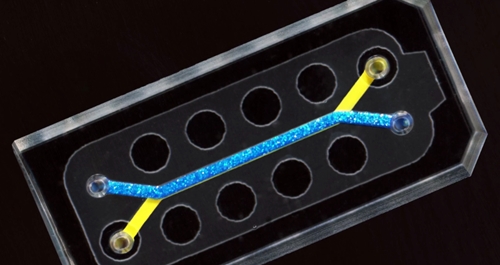22 December 2015. A biomedical engineering lab at Harvard University developed a small chip device that acts as a model of human airways to study biological processes and test drugs for diseases such as COPD and asthma. A team from Harvard’s Wyss Institute for Biologically Inspired Engineering describe the device in yesterday’s issue of the journal Nature Methods (paid subscription required).
The paper’s two senior authors, Donald Ingber and Geraldine Hamilton, founded Emulate Inc., a spin-off company from the Wyss Institute in 2014, as reported in Science & Enterprise, to commercialize the institute’s work on organ chip models. The company yesterday announced an expanded collaboration with the pharmaceutical company Merck to refine airway and intestine chip models for drug testing. Merck and drug maker Pfizer were among the funders of the Nature Methods paper.
The chip is designed to provide a platform to study outside the body airway disorders, such as chronic obstructive pulmonary disease, or COPD, and asthma. COPD, is a progressive respiratory disorder that makes it difficult to breathe, and causes coughing, wheezing, shortness of breath, and tightness in the chest. The leading cause of COPD is cigarette smoking, but other irritants like chemical fumes or air pollution can contribute to the condition. Two major forms of the disease are emphysema, where walls between air sacs in the lungs are damaged and chronic bronchitis, where the lining of the airways is constantly irritated and inflamed.
Asthma is chronic condition, where the airways become inflamed and narrow, causing people with asthma to experience wheezing, shortness of breath, tightness in the chest, and coughing for periods of time. Among asthma’s underlying causes are pollutants in the air and allergies to pollen, molds, or dust mites that trigger airway inflammation. Centers for Disease Control and Prevention estimates that in 2010 some 18.7 million adults had asthma, along with 7 million children.
The chip is a hand-held microfluidic device that models the cellular architecture of the human small airway. A first author of the paper and former postdoctoral researcher Remi Villenave says in a Wyss Institute statement the device “contains a fully matured human small airway epithelium [surface cell layer] with different specialized cell types exposed to air in one of its two parallel microchannels.”
Villenave adds that “The second channel is lined by a human vascular endothelium [blood vessel lining cells] in which we flow medium containing white blood cells and nutrients so that the living microsystem can be maintained over weeks.”
The researchers used the chip to simulate asthma by introducing asthma-inducing immune factors, and COPD with lung surface cells from COPD patients. Not only does the chip under these conditions react like human airways in people with asthma and COPD, but it also shows how these conditions worsen when exposed to bacterial or viral infections. The authors report tests with the airway chip revealed a possible new biomarker for viral exacerbations of COPD.
Co-first author and postdoctoral researcher Kambez Hajipouran Benam notes that the chip “provides us with a handle to dissect contributions of specific cell types and biochemical factors to small airway diseases, including how circulating immune cells are recruited to inflammation sites and how compromised cilia function contributes to abnormal mucus clearance in the lungs of diseased patients.”
The airway chip can also serve as a testing platform for new respiratory disease therapies. Among the funders of the research on the device are the pharmaceutical companies Merck and Pfizer that also provided co-authors of the journal paper. The paper reports proof-of-concept results with the chip showing two drugs address different cells in the airway that suppress molecular components of inflammatory pathways associated with asthma and COPD.
Merck is collaborating with Emulate Inc., the spin-off enterprise from Wyss Institute, to refine the chips’ drug discovery functions. The agreement calls for Emulate to provide Merck with access to its small airway and intestine chips for drug discovery, with Emulate retaining rights to any discoveries from the collaboration. Senior author of the journal article and Wyss Institute director Donald Ingber is one of Emulate’s scientific advisors, while senior co-author Geraldine Hamilton is Emulate’s president and chief scientist.
The following video tells more about the airway chip project.
- Trial Tests Vibrating Mattress to Prevent Infant Apnea
- Spin-Off to Provide Lower-Cost Molecular Imaging Technology
- Harvard Spin-Off Commercializing Sepsis Treatment
- Injected Gel Designed to Deliver Cancer Therapy
- Institute Developing Engineered Bacteria for Gut Diseases
* * *


 RSS - Posts
RSS - Posts
You must be logged in to post a comment.